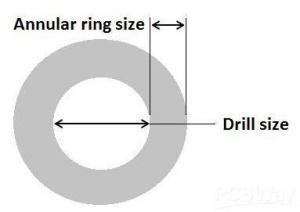Annular rings are a vital part of any printed circuit board (PCB), but they pose quite a challenge for PCB designers. With such precise work, it’s easy to make mistakes with drilling the via, which can lead to malfunctioning on the board itself.
PCB designers have to be careful when calculating size and placement. In this article, we’ll explore everything you need to know about annular rings, the unique challenges they present, and how to get them right.
What Is An Annular Ring?
The annular ring is nothing but a technical term that is designated to the area drilled into the PCB. The hole that is created by the process serves as an interconnecting node between different layers of the circuit.

But before you know the basics of annular ring creation, it is important to know how the via is made. It usually starts during the PCB manufacturing process. To fulfill the general requirements, PCB boards are etched with a hole in which copper is deposited through electroplating.
After the PCB construction is finished, these hole-like structures that act as a connection between PCB pads appear as rings when viewed from above. Another specialty of annular rings is that they differ in size. Depending on the requirement, they can either be thick or thin.
How Do You Calculate the Annular Size?
When constructing an annular ring, the goal is to drill right through the center. The more accurate that hole is, the more seamlessly electricity conducts through.
To get the correct width for an annular ring, use a simple equation:
- Width of Annular Ring = (Copper Pad Diameter – Diameter of Finished Hole/Via) / 2
So you take the diameter of the copper pad, which is the outer circle, and subtract the diameter of the via, which is the inner circle. Take that number and divide it in half to get the perfect width of your annular ring.
Why Does the Annular Ring Size Matter?
The size of the annular ring matters because it determines the success of your conductivity. While you don’t want it to be too wide since you’re working with a tiny space, you do need it to be wide enough to keep the connection strong.
How to Get the Annular Ring Size Right
Each PCB manufacturer will stipulate the tolerance for the annular ring through the PCB manufacturing process. However, to be on the safe side, you should always add a little more space.
Most designers recommend increasing the size by 1.0mm from the manufacturer’s specifications. The slight extra width will help prevent any issues later on.
The size of your annular rings will also depend on what you’re designing the board for. The Institute of Printed Circuit Boards specifies three categories for PCBs: Class 1, Class 2, and Class 3. Heavy-duty PCBs need larger annular rings because the via will be wider in diameter. Class 3 PCBs require more heavy-duty annular rings.
What Is the Minimum Annular Ring in PCB?
While some PCBs support heavy-duty equipment and spaces, others must be extremely compact. Think of PCBs in smartphones or small technological equipment.
In this case, the minimum annular ring has to be correspondingly tiny. But just how small can we go?
The design standard across the industry sets a different limit for inner and outer annular rings.
- For annular rings on the inner layer of a PCB, the minimum width is 0.1mm.
- For annular rings on the outer layer of a PCB, the minimum width is 0.05mm.
You can learn more about design limits on Candor.
What Is the Difference Between a PCB Annular Ring and a Through-Hole?
Whenever you hear the term PCB, you probably think of the through-hole method. It is a technique used to mount electronic components. The electronic components insert into holes drilled in a PCB.
Through-holes are a type of via, but not all vias are through-holes. Through-holes use leads inserted into the hole and then soldered onto the copper pad to create conductivity.
On the other hand, Annular rings create conductivity by directly connecting the copper-plated via to the copper pad.
What Is the Teardrop Annular Ring?
A teardrop annular ring is teardrop-shaped. Instead of designing a perfect circle, you add extra copper to connect the ring’s outer edges. The additional copper gives the ring some added strength.
The main reason to use teardrop annular rings is if the drill bit goes slightly off course during drilling. This problem can remove too much copper and jeopardize the connection.
Teardrop annular rings can:
- Reduce the risk of cracking on thin copper
- Reduce mechanical or thermal stress
- Protect small misalignments in the drill hole
